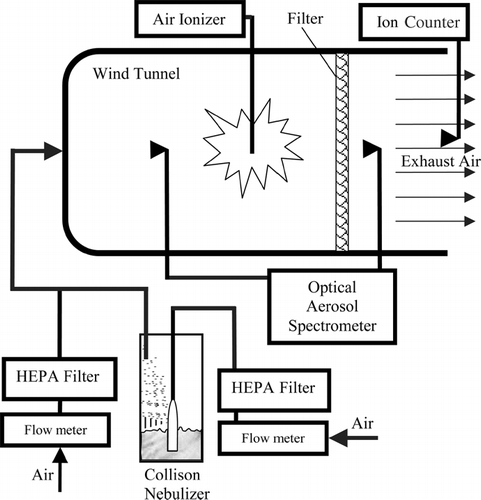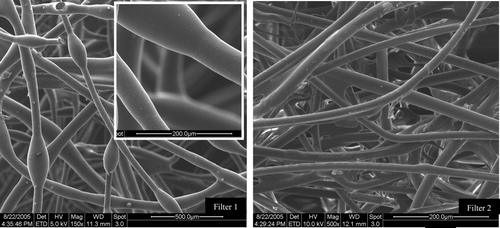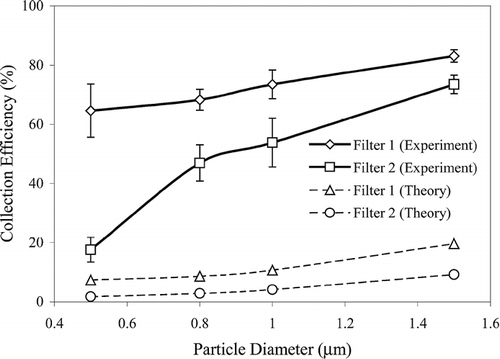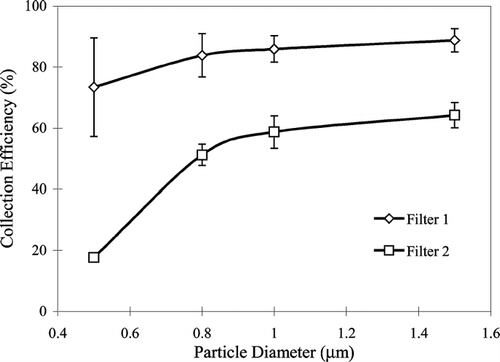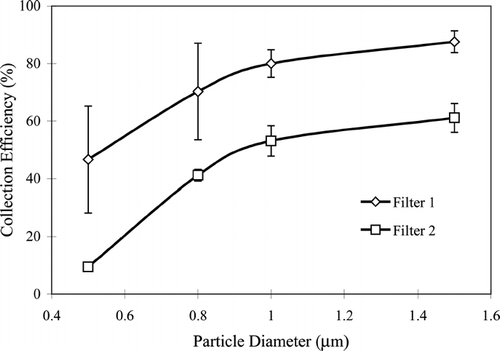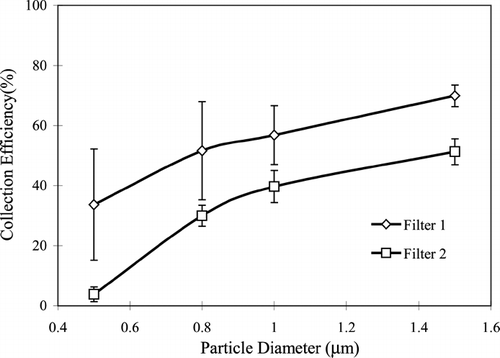Our novel concept utilizing continuous emission of unipolar ions, which has been recently proven to enhance the efficiency of facepiece respirators, was applied to conventional HVAC filters. Laboratory study demonstrated that the air ion emission in the vicinity of a low-efficiency HVAC filter significantly improves its performance. For example, the collection efficiency of two commercial HVAC filters challenged with 1μm PSL particles jumped from 5–15% (measured with no ion emission) to 40–90% (when the ion output rate was ∼ 1012 e−/sec). The enhancement effect depends on the filter type and, generally, on the distance from the ion emitter to the filter surface. The results were explained as follows. The air ions with high mobility are deposited on the fibers forming a macroscopic electric field, which shield out some incoming unipolarly charged particles due to repelling forces. The field estimate has shown that this explanation is feasible. The enhancement effect seems to have a good potential to be employed in industrial and residential ventilation systems as it enhances the aerosol collection efficiency of a low-efficiency HVAC filter while not affecting its pressure drop.
INTRODUCTION
Increasing public concerns regarding air quality in residential and non-residential buildings have necessitated the development of efficient indoor aerosol filtration techniques. This topic has recently received additional attention because of the threat of bioterrorism. Reduction of human exposure to fine and ultrafine aerosol particles, including biological agents, in indoor environments has been particularly recognized due to the health effects associated with respirable particles of biological and non-biological origin (CitationAmerican Lung Association 1997; CitationGammage and Berven 1996; CitationInstitute of Medicine [IOM] 2000, Citation2004; CitationNational Institute for Occupational Safety and Health [NIOSH] 2003; CitationSpengler et al. 1993).
Central heating, ventilation, and air-conditioning (HVAC) filtration systems remain the main tool for controlling aerosol pollutants in buildings. Commercially available HVAC filters represent a wide range of collection efficiencies for fine and ultrafine particles. Some sophisticated high packing density fiber filters, charged-fiber electret filters, and electrostatic precipitators can provide the collection efficiency as high as 99% or greater for respirable particles, including viruses, bacteria, as well as bacterial and fungal fragments. However, the majority of single-family homes and large buildings are equipped with much less expensive, low-packing-density fiber HVAC filters, which are characterized by low collection efficiency that allows 70% to almost 100% of particles in the above size range to penetrate through the filter media. More efficient filters with high-packing density often cause higher initial pressure drop, which may further increase with the time of operation due to loading. Thus, alternative techniques are needed that will allow decreasing the aerosol particle penetration through low-efficiency HVAC filters while not affecting their pressure drop.
Using of electret filters is becoming increasingly popular to meet high efficiency and low pressure drop requirements. Such filters are made of pre-charged fibers, which significantly enhance the efficiency of particle removal due to electrostatic mechanism. Various methods to produce charged fibers, including electrostatic charging (CitationTsai et al. 2002), pre-treatment with ionic surfactants (CitationYang and Lee 2005) and others are used; however, the electret filter lifetime is still very short compared to conventional filters utilizing mechanical mechanisms of the particle removal such as diffusion, inertia and interception (CitationRaynor and Chae 2004). Some attempts have also been made to extend the electret filters' lifetime by varying the packing density along the thickness of the media (CitationSae-lim et al. 2005). The authors managed to quadruple the filter service life by packing the filter loosely on the inlet side and progressively more densely towards the outlet side (the ratio of packing densities was up to 7 times).
Our earlier studies (CitationLee et al. 2004a, b) revealed that the protection provided by a filtering facepiece respirator can be significantly enhanced due to unipolar air ionization in the vicinity of the respirator. Based on this finding, we hypothesized that the performance of low-efficiency HVAC filters could also be significantly improved if the unipolar ions are continuously emitted near the filter surface. This hypothesis has been tested in the present work through experimental and theoretical investigations undertaken with two commercially available, widely used HVAC filters.
EXPERIMENTAL METHODS
Setup
The laboratory setup developed for this investigation is presented in . The HEPA-filtered air, mixed with the challenge aerosol generated by a 3-jet Collison nebulizer (Model: MRE 24/25, BGI Inc., Waltham, MA), entered the test aerosol chamber—a 70 cm long open-loop cylindrical wind tunnel. HVAC filter with an operational cross-section of 6 cm in diameter was installed inside the wind-tunnel. Prior to each experiment, the nebulizer was charged with monodisperse polystyrene latex (PSL) spheres (Bangs Laboratories, Fishers, IN, USA) of a specific diameter: 0.5, 0.8, 1.0, and 1.5 μm. To investigate the influence of air ionization on the filtration process, the negative air ion emitter (Wein Products, Inc., Los Angeles, CA, USA) with an output rate of ∼1012 e−/sec was continuously operated in the aerosol chamber at different distances from the HVAC filter. The aerosol concentration and particle size distribution upstream and downstream of the test filter/ionizer were monitored by an optical aerosol spectrometer (Model 1.108, Grimm Aerosol Technik, Ainring, Germany). The experiments were performed at a relative humidity of 50–55% and air temperature of 22–24°C (measured by VelociCalc Plus, Model 8386, TSI, Inc., St. Paul, MN, USA).
Filters
Two commercially available low-efficiency HVAC filters made of polyester were tested. These materials were selected to represent the deep filtration (Filter 1) and the surface filtration (Filter 2)—two types, which are commonly used for industrial and domestic applications. The Scanning Electron Microscope (SEM) images presented in show their structure, fiber orientation and packing arrangement. The scales of the main SEM pictures in are different. To enable a more convenient comparison, the inset on the photograph of Filter 1 is presented in the same scale as the photograph of Filter 2.
The characteristics of these filters are summarized in . The fiber sizes were determined by examining randomly sampled fibers (20 per filter) using a polarising microscope (Model: Zeiss Standard 25, Carl Zeiss, Germany) with a ×10 objective lens and a graduated eyepiece. All fibers were considered to be cylindrical, and the measurements were conducted at their perfectly cylindrical regions. The thickness of the filters was measured using two approaches, For Filter 1 that was as thick as 20 mm, it was sufficient to use a micrometer (ensuring minimal deforming of the media). Filter 2 (much thinner) was characterized through microscopic measurements: a thin strip of the filter was vertically secured on the stage and measured at different points. To determine the overall packing density of the material for each filter type, ten samples of the same size were weighed on the analytical balance (Model: HR-202, A&D, Tokyo, Japan) with the resolution of ±0.01 mg.
TABLE 1 Characteristics of the tested HVAC filter materials
Procedure
A horizontal wind tunnel simulating an HVAC system was designed and built out of a multi-layer paper material, to evaluate the performance of commonly used low-efficiency HVAC filters. The wind tunnel grounded to minimize the effect of charged walls. The tested filter was aligned vertically and clamped between two rings, with the airflow passing through the filter. A challenge aerosol (6 L/min) was firstly mixed with a humidity-controlled air (180 L/min) to create a concentration of approximately 104 particles per liter, charge-equilibrated by an 85Kr sealed source (Model: 3012, TSI Inc., St.Paul, MN, USA), entered the test zone and passed through the HVAC filter at the face velocity of 1.1 m/sec. Based on the size-selective aerosol concentration measurements conducted upstream and downstream of the filter, the filter collection efficiency was determined for each particle size as:
The measurements were first performed with no ion emission in the test zone. Then the negative air ion emitter was turned on upstream of the filter. The tests were conducted with the emitter located at four different distances to the filter ranging from 5 to 45 cm. The Air Ion Counter (AlphaLab Inc., Salt Lake City, UT, USA) was deployed to assess the ion concentration in the air at different distances from the ion emitter. The instrument was placed in the wind tunnel to monitor the ion flux during experiments and ensure that the system has reached equilibrium (no further accumulation of charge on the walls of the tunnel and filter). Prior to each experimental run, the zero aerosol concentration was verified by passing a HEPA-filtered air through the aerosol chamber (with no air flow from the nebulizer).
THEORETICAL ANALYSIS
The filter efficiency was also calculated based on the single fiber efficiency concept (CitationHinds 1999):
In the case when the ionizer is switched off, particles have essentially zero charge, and the electrostatic image force does not contribute in the filter efficiency. When air ions are emitted, the electrostatic term can be evaluated as (CitationHinds 1999):
RESULTS
The air ion concentration in a close vicinity of the ion emitter exceeded the upper limit of the Air Ion Counter (2 × 106 ions/cm3). It decayed rather quickly in the wind tunnel with increasing the distance between the ion source and the filter surface beyond 20–30 cm. This suggests that the effect of ion emission on the filter performance may be dependent on the distance between the filter and ionizer if this distance is sufficiently long. Also, we observed considerable variability of the ion flux during the first few seconds after commencement of each run, but it quickly reached an equilibrium indicating that the process had reached a steady state.
represents the background filter efficiency data when the ionizer does not operate. Both the experimental and theoretical results are plotted for each of the two tested filters. The graphs show that the filter efficiencies for the particles of 0.5 to 1.5 μm are low. Even the more efficient Filter 1 collects < 20% of particles in this size range. The theoretical and experimental data presented in demonstrate a good agreement.
When unipolar (negative) ions were emitted upstream of the filter (at a distance of 5 cm), the measured collection efficiency increased compared to the background levels, see versus (experimental data). Both filters demonstrate a substantial performance improvement (up to an order of magnitude) for different particle sizes. In contrast to the experiment, the theory does not predict considerable increase in the collection efficiency even if the q-value in Equation (Equation3) is postulated to be the maximum possible charge acquired by an aerosol particle due to diffusion charging. Such conclusion is based on the values of 20, 33, 47, and 62 elementary charges for particle sizes of 0.5, 0.8, 1.0, and 1.5 μ m, respectively (CitationHinds 1999).
, , and representing the filter efficiencies measured with the ion emitted operated at 15, 25, and 45 cm from the HVAC filter surface, respectively, demonstrate the same trend: the ion emission in the vicinity of the filter enhances its performance. Interestingly, according to the single factor ANOVA test, there is no significant difference (p > 0.05) between the filter efficiency values obtained with the air ion source placed at distances of 5 and 15 cm from the filter. This conclusion made for both tested filters can be attributed to very high concentration of air ions in the vicinity to the filter, which occurred when the emitter was relatively close to the filter surface. The efficiency enhancement is less pronounced (but still significant) when the ion source is placed further upstream of the filter as the charge near the filter surface decreases. As the distance increases to 25 cm and especially 45 cm, similar ANOVA tests start showing significant dependence of the collection efficiency of both filters on the distance (p < 0.05).
Also, a separate experiment has been undertaken to assess the particle losses on the walls of the wind tunnel. To perform the experiment, the filter was removed from the device and the particle concentration was measured at the tunnel inlet and outlet, respectively. This was done for the cases when the ionizer was on and off. We found that the wall losses in the tunnel with non-operating ionizer did not exceed 1% while they increased to 10–20% when the ionizer operated. No difference was observed when the device was grounded versus non-grounded.
The pressure drop measured across Filter 1 was 82 Pa and that across Filter 2 was 68 Pa for the air velocity used in the experiments (1.1 m/s).
DISCUSSION
The data suggest that continuous emission of unipolar ions in the vicinity of a low-efficiency HVAC considerably improve its performance. The collection efficiency of both commercial filters tested in this study with particles of 0.5–1.5 μ m increased by up to an order of magnitude due to air ionization. For example, for 1 μ m particles, the collection efficiency jumped from about 5–15% (measured with no ion emission) to about 40–90% (with ion emission), depending on the distance from the ion emitter to the filter surface and the filter type. The wall losses inside the wind tunnel (assessed above) were not big enough to solely explain this efficiency increase.
It is intriguing that the conventional filtration theory does not predict such a sizable increase of the collection efficiency due to ionization that was found experimentally (see ). The above disagreement was attributed to the following mechanism. The air ions having high mobility are captured by the fibers, which creates a macroscopic electric field. The latter affects the motion of charged incoming particles as well as the particle motion inside the filter structure. Unipolarly charged particles, which approach the filter surface, are affected by two forces acting in opposite directions; drag and Coulomb's repelling force. The difference in these forces would cause some particle deceleration in the vicinity to the filter face. This deceleration depends on several parameters.
The ion deposition onto a single fiber will continue as long as the ion kinetic energy is sufficient to overcome repelling. Then, equating the work of the electric field along the free molecular path (a negative energy acquired by the ion) to the ion kinetic energy, we obtain the maximum electric filed of the fiber, when the deposition is still possible
From Equations (Equation5)–(Equation7):
From Equation (Equation4):
Obviously, as the incoming aerosol charged by air ions exhibits a certain particle charge distribution and because the fiber structure has a pronounced spatial variability, only a certain fraction of particles will be shielded out; the others will enter the filter structure and either deposit inside or penetrate through it. We believe that the difference between the experimental and theoretical values of the filter efficiency obtained in this study represents the particles, which were shielded out upstream of the filter by the repelling force. The above analysis demonstrates the reason why this difference depends on the filter parameters and the particle size as seen on , , , .
CONCLUSIONS
Laboratory tests demonstrated that continuous unipolar air ion emission in the vicinity of a low-efficiency HVAC filter significantly improves its performance while not affecting its pressure drop. For example, the collection efficiency of two commercial HVAC filters challenged with 1 μm PSL particles jumped from about 5–15% (measured with no ion emission) to about 40–90% (when the ion output rate was ∼1012 e−/sec). The enhancement effect depends on the filter type and, generally, on the distance from the ion emitter to the filter surface. The theoretical model accounting for the particle deposition on fibers appeared to underestimate the effect because it does not consider the possibility that some incoming particles may be shielded out upstream of the filter due to repelling forces caused by unipolar ions captured by the fibers. The findings of this study can be used for improving the air cleaning efficiency of industrial and residential ventilation and air conditioning systems.
REFERENCES
- American Lung Association . 1997 . Residential Air Cleaning Devices: Types, Effectiveness, and Health Impact , Washington, DC : American Lung Association .
- Gammage , R. B. and Berven , B. A. 1996 . Indoor Air and Human Health , New York : CRC Press .
- Hinds , W. C. 1999 . Aerosol Technology: Properties, Behavior, and Measurement of Airborne Particles, , 2nd Edition , New York : Wiley-Interscience .
- Institute of Medicine . 2000 . Clearing the Air: Asthma and Indoor Air Exposures , Washington, DC : The National Academies Press .
- Institute of Medicine . 2004 . Damp Indoor Spaces and Health , Washington, DC : National Academy of Sciences .
- Lee , B. U. , Yermakov , M. and Grinshpun , S. A. 2004a . Removal of Fine and Ultrafine Particles from Indoor Air Environments by the Unipolar Ion Emission . Atmos. Environ. , 38 : 4815 – 4823 . [CSA]
- Lee , B. U. , Yermakov , M. and Grinshpun , S. A. 2004b . Unipolar Ion Emission Enhances Respiratory Protection Against Fine and Ultrafine Particles . J. Aerosol Sci. , 35 ( 11 ) : 1359 – 1368 . [CROSSREF] [CSA]
- National Institute for Occupational Safety and Health (NIOSH) . 2003 . Guidelines for Filtration and Air-Cleaning Systems to Protect Building Environments from Airborne Chemical, Biological, or Radiological Attacks , Edited by: Earnest , G. S. and Gressel , M. DHHS-CDC-NIOSH . Publ. No. 2003–136
- Raynor , P. C. and Chae , S. J. 2004 . The Long-Term Performance of Electrically Charged Filters in a Ventilation System . Journal of Occupational and Environmental Hygiene , 1 ( 7 ) : 463 – 471 . [INFOTRIEVE] [CROSSREF] [CSA]
- Sae-lim , W. , Tanthapanichakoon , W. and Kanaoka , C. 2005 . Structural Improvement to Quadruple Service Life of a High-Efficiency Electret Filter . Sci. Techn. Adv. Materials. , 6 ( 3–4 ) : 307 – 311 . [CSA]
- Spengler , J. , Neas , L. , Nakai , S. , Dockery , D. , Speizer , F. , Ware , J. and Raizenne , M. 1993 . Respiratory Symptoms and Housing Characteristics . Proc. Indoor Air , 1 : 165 – 168 . [CSA]
- Tsai , P. P. , Schreuder-Gibson , H. and Gibson , P. 2002 . Different Electrostatic Methods for Making Electret Filters . J. Electrostatics , 54 ( 3–4 ) : 333 – 341 . [CROSSREF] [CSA]
- Yang , S. H. and Lee , G. W. M. 2005 . Filtration Characteristics of a Fibrous Filter Pretreated with Anionic Surfactants for Monodisperse Solid Aerosols . J. Aerosol Sci. , 36 ( 4 ) : 419 – 437 . [CROSSREF] [CSA]
